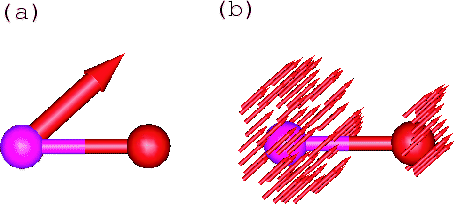 |
A fully unconstrained non-collinear density functional theory (DFT) is supported including the spin-orbit coupling (SOC) [6,7,8,9,13]. When the non-collinear DFT is performed, the following option for the keyword 'scf.SpinPolarization' is available.
scf.SpinPolarization NC # On|Off|NC
<Atoms.SpeciesAndCoordinates # Unit=Ang
1 Mn 0.00000 0.00000 0.00000 8.0 5.0 45.0 0.0 45.0 0.0 1 on
2 O 1.70000 0.00000 0.00000 3.0 3.0 45.0 0.0 45.0 0.0 1 on
Atoms.SpeciesAndCoordinates>
1: sequential serial number
2: species name
3: x-coordinate
4: y-coordinate
5: z-coordinate
6: initial occupation for up spin
7: initial occupation for down spin
8: Euler angle, theta, of the magnetic field for spin magnetic moment
9: Euler angle, phi, of the magnetic field for spin magnetic moment
Also, the 8th and 9th are used to generate the initial non-collinear
spin charge distribution
10: the Euler angle, theta, of the magnetic field for orbital magnetic moment
11: the Euler angle, phi, of the magnetic field for orbital magnetic moment
12: switch for the constraint schemes specified by the keywords
'scf.Constraint.NC.Spin', 'scf.NC.Zeeman.Orbital' and 'scf.NC.Zeeman.Orbital'.
'1' means that the constraint is applied, and '0' no constraint.
13: switch for enhancement of orbital polarization in the LDA+U method,
'on' means that the enhancement is made, 'off' no enhancement.
The initial Euler angles, *.nc.txt *.ncsden.txt
The spin moment and Euler angles of each atom, which are calculated by Mulliken analysis, are found in the *.out file as follows:
***********************************************************
***********************************************************
Mulliken populations
***********************************************************
***********************************************************
Total spin moment (muB) 4.997792547 Angles (Deg) 45.001196562 0.000000622
Up Down Sum Diff theta phi
1 Mn 8.63989 3.91894 12.55883 4.72096 44.99801 0.00000
2 O 3.35900 3.08217 6.44117 0.27684 45.05555 0.00000
Also it should be noted that it is difficult to achieve a self consistent
field in the non-collinear DFT more than the collinear DFT calculation,
since there are many minima, having almost comparable energy, in the
spin orientation space, while the constraint DFT is useful for such a case.
In the non-collinear DFT, the inclusion of spin-orbit coupling is supported, while it is not supported for the collinear DFT. See also the Section 'Relativistic effects' for the issue.
 |